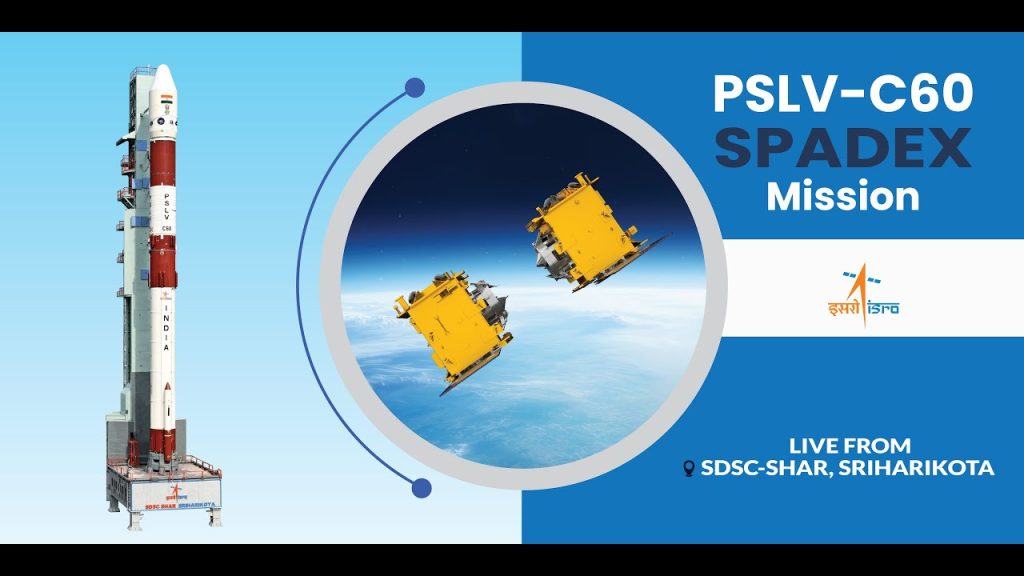
India’s space exploration journey has taken another significant leap forward with the ISRO PSLV-C60 SPADEx mission. The Indian Space Research Organisation (ISRO) continues to demonstrate its prowess in space technology, cementing its position among the world’s leading space agencies. In this article, we delve into the intricacies of the PSLV-C60 mission, its objectives, payloads, and the broader implications for the future of space exploration.
Introduction to the PSLV-C60 Mission
The Polar Satellite Launch Vehicle (PSLV) has been the workhorse of ISRO, known for its reliability and versatility. The PSLV-C60 mission is yet another feather in the cap of this robust launch vehicle series. This mission is particularly noteworthy as it incorporates the SPADEx (Spacecraft Positioning and Data Exchange) system, a cutting-edge advancement aimed at enhancing satellite communication and positioning.
The PSLV-C60 was launched from the Satish Dhawan Space Centre (SDSC) SHAR, located in Sriharikota, Andhra Pradesh. This state-of-the-art facility has been the cradle of many of India’s pioneering space endeavors. The launch, conducted with meticulous precision, signifies ISRO’s commitment to achieving excellence in space technology.
Mission Objectives
The PSLV-C60 SPADEx mission was conceived with several critical objectives:
- Deployment of Advanced Satellites: The mission successfully deployed multiple satellites into precise orbits. These satellites are equipped with sophisticated instruments for Earth observation, communication, and scientific research.
- Testing SPADEx System: The SPADEx system is designed to revolutionize how spacecraft communicate and share data, ensuring real-time updates and enhanced efficiency.
- Strengthening Global Collaboration: The mission also featured international payloads, highlighting ISRO’s growing role in fostering global partnerships in space exploration.
- Demonstrating Reusability and Cost Efficiency: As part of ISRO’s ongoing efforts to reduce costs, the PSLV-C60 mission included components that push the boundaries of reusability and operational efficiency.
Key Payloads and Technologies
The PSLV-C60 carried an array of innovative payloads, each serving a unique purpose:
1. Earth Observation Satellites
These satellites are equipped with high-resolution cameras and sensors for detailed imaging and monitoring of the Earth’s surface. Applications include:
- Agricultural Monitoring: Providing critical data for crop health and yield estimation.
- Disaster Management: Facilitating timely response during natural calamities by monitoring weather patterns and land changes.
- Urban Planning: Assisting in infrastructure development and land-use analysis.
2. SPADEx System
The SPADEx system stands out as a hallmark of this mission. This revolutionary technology enables:
- Enhanced Data Exchange: Facilitating seamless communication between multiple satellites.
- Improved Positioning Accuracy: Ensuring satellites maintain precise orbits for optimal functionality.
- Energy Efficiency: Reducing power consumption during data transmission, extending satellite lifespans.
3. International Collaboration Payloads
The mission included payloads from partner countries, furthering ISRO’s vision of making space exploration a collaborative global endeavor. These payloads bring technological diversity and strengthen diplomatic ties through shared achievements.
The Launch Vehicle: PSLV’s Reliability
The PSLV-C60 reaffirms the legacy of the PSLV series, renowned for its:
- Versatility: Capable of deploying satellites into various orbits, including Sun-synchronous and geostationary transfer orbits.
- Track Record: Boasting a high success rate, the PSLV has launched over 300 satellites, earning global trust.
- Cost-Effectiveness: Providing affordable launch solutions without compromising on quality and reliability.
The vehicle’s configuration for this mission included advanced boosters and an enhanced payload capacity, ensuring flawless execution.
Implications for India and the Global Space Industry
1. Strengthening India’s Space Capabilities
The successful execution of the PSLV-C60 SPADEx mission highlights India’s growing technological prowess. It enhances the country’s ability to provide cutting-edge solutions in Earth observation, navigation, and communication.
2. Boosting Commercial Opportunities
ISRO’s ability to deliver cost-effective and reliable launch services positions India as a preferred partner for satellite launches. The PSLV-C60 mission reinforces this reputation, opening doors to more international collaborations and commercial contracts.
3. Advancing Scientific Research
The data generated by the mission’s payloads will contribute to various scientific domains, including climate studies, space weather analysis, and deep space exploration.
4. Inspiring Innovation and Education
Achievements like the PSLV-C60 mission inspire a new generation of scientists, engineers, and entrepreneurs. They foster innovation, drive educational advancements, and create a robust ecosystem for space technology development.
Future Prospects and Missions
The PSLV-C60 SPADEx mission is a stepping stone to even greater achievements. ISRO’s roadmap includes:
- Reusable Launch Vehicles (RLVs): Efforts to enhance reusability to make space exploration more sustainable.
- Human Spaceflight Programs: Initiatives like the Gaganyaan mission aim to send Indian astronauts to space.
- Deep Space Exploration: Ambitious projects to explore the Moon, Mars, and beyond.
- Commercial Satellite Constellations: Developing low-cost constellations to provide global broadband services.
Conclusion
The ISRO PSLV-C60 SPADEx mission is a testament to India’s unwavering commitment to advancing space exploration. By leveraging innovative technologies and fostering international collaborations, ISRO continues to push the boundaries of what is possible. This mission not only showcases India’s technical capabilities but also reinforces its role as a leader in the global space community.
